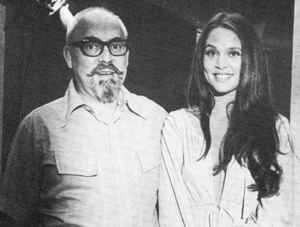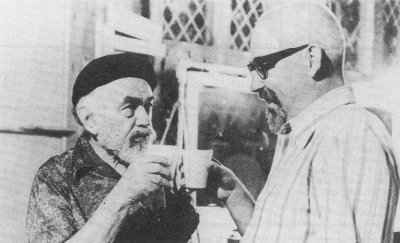A Cannibalised Novel Becomes

by Harry Harrison
|
As is standard Hollywood practice, the author of the book upon which this film is based was treated shabbily. All the usual tricks were used: a dummy company was set up to disguise the fact that it was really MGM buying the film rights; a contract was drawn up to prevent the author from having any control over the screenplay - and, of course, creative bookkeeping made certain none of the film's profits reached the author. But these sordid facts are of importance only to the well-screwed author; let us put them aside and look instead at the transition from book to film, since this is where the heavy hand of corporate filmmaking is so revealing.
The originators of the film, its star Charlton Heston, and its producer Walter Seltzer had been pressing MGM for years to make a film on the theme of overpopulation based on my novel Make Room! Make Room!. (That they neglected to inform me of this fact is part of the author-screwing syndrome: see paragraph 1.) MGM, in its infinite wisdom, thought this theme of little importance. So in an attempt to breathe life into the "inconsequential" topic, the film's originators introduced the theme of cannibalism: "soylent green," the food that the authorities give the masses, is made of human remains. Heads nodded in high places at the studio, agreements were signed - and the film went into production. 
This is when I came onto the scene, to be instantly impressed by two inescapable facts: the truly professional ability of everyone connected with the making of the film and the truly appalling quality of the script, which transmogrified, denigrated, and degutted the novel from which it had been taken. That a successful film was made despite what might be considered a major obstacle can be credited to the art and set designers, the director Richard Fleischer, and to the fine actors (as well as to, I submit with suitable humility, the strength of the novel). Although forbidden by contract to make any changes in the script, I nevertheless pointed out a number of inaccuracies and mistakes I discovered. Credit goes to the filmmakers for taking instant action on them. The film's opening is a prime example. In the original script the action began in Manhattan, no date given. I pointed out to Walter Seltzer that my novel was special specifically because it took place in the very near future, at the turn of the century. By ignoring this element, the film would lose the sense of immediacy and relevance for which the rights to my book had, presumably, been purchased in the first place. Soon after acting upon my remarks, Walter chided me because I had made him spend a lot of money. It proved to be money well spent - on Chuck Braverman. His impressive opening montage, comprised of still shots tracing the settling and growth of the USA, ending with the overpopulated and polluted New York City, firmly places the film in time.
There are other examples of the filmmakers' dedication. When I was shown the set for the "meatlegger" sequence I was suitably impressed. However, I thought that the pile of plastic bags was out of place since plastic is a petroleum product and all of the world's petroleum had been used up by this time. The bags were instantly whisked away. I propagandised everyone in sight, from grips to actors, by giving them copies of the original book. When Chuck Connors got his, he called across the set to the director, "Hey, Dick, why aren't you using this title instead of the crappy Soylent Green?" The answer, which Fleischer perhaps did not know, was the decision made in high places that my title might be associated with a long-dead TV series named "Make Room for Daddy." Moral: when you throw away a good title you always get a bad one.  Real evidence of the dubiety of the screenplay was driven home to me when I overheard a remark made by Edward G. Robinson to the director. His worry was a simple one: there was nothing in the script that gave him any idea of what his role was to be. Summoning up my courage I introduced myself and offered to provide answers about his character. He ignored my rudeness, invited me to lunch with him, then listened closely when I explained the character he played as I had visualised him in the book: Sol is the sole survivor of the good days, the only person who had lived in the world of plenty. He can survive in this new world of pollution, over-population, and chronic food shortages. That doesn't mean he has to like it. This conversation led, a few days later, to an act of cinematic creation that it was my privilege to witness. They were shooting a key scene where Sol and Thorn (Heston) are eating some pilfered blackmarket food. The script was devoid of directions or content, the dialogue banal. Yet before our eyes the director and the actors built a new scene that embodied the essence of the book - and the film. Heston pantomimed simple pleasure at the loathsome artificial food - all he had ever known. Robinson virtually embodied repulsion and despair. When Fleischer called out "Cut!" the professional audience, only carpenters, grips, and technicians - no visitors - burst into spontaneous applause. This was artistic appreciation at its very best. The impressive results grace the film. A great strength of this film is its strong visual content, the correct utilisation of the large screen, the escape from TV's talking heads. Much credit to the art director, director, and cameraman. The green pall that hangs in the air makes the viewer aware at all times of this polluted and overcrowded world. It also adds emphasis to the beautiful Braverman graphics - with Beethoven's "Pastoral" playing in the background - during the suicide parlour scene. A perfect example of visual strength overriding content. In the book, Sol is a loner, a survivor, and dies after taking a public stance for the very first time in his life. The one thing that he would never do would be to commit suicide. Completely ignoring this fact, the inept screenwriter brings in that old sf cliché, the suicide parlour. Something I would never do. Ironically, it works in the film since it is new to cinema audiences. The scene, which includes images of the clean and beautiful world as it once had been, also adds to the film's impact.  This continual visual onslaught conveys the message of the book - modified for film. The idiotic cannibal-crackers (not in the book) and the "big" revelation that they are made from corpses will have been twigged by the audience early on. This, and the murder and chase sequences, the "furniture" girls (not in the book) are not what the film is about - and are completely irrelevant. The film, like the book, shows what the world will be like if we continue in our insane manner to pollute and overpopulate Spaceship Earth. This is the "message" of film and book. Both of them deliver this message in a manner unique to science fiction: the technique of background-as-foreground. This means simply that the story played out by the characters is not the major story. It is the means to capture the reader / viewer's attention, to reveal a greater truth in the setting where the foreground takes place. Other examples of background-as-foreground films- from-books are 1984 (1956) and On the Beach (1959). All right then - what kind of a film is Soylent Green? Put all thoughts of the book aside and judge the film on its own merits. Its greatest strengths are the design and the acting. The cornball chase sequences, the over-dramatic ending, the numerous infelicities of writing and plotting can be ignored. The film is a visual success. The background of this terrible world is punched home like an inescapable drumbeat. The after-shock is very strong. Almost every person that I have talked to had the same delayed reaction: a week or more after viewing the film, memory of the action had dimmed - but the feeling of horror of this world had grown and intensified. The background had become the foreground.
Am I pleased with this film? I would say fifty percent. The message of the book has been delivered. It was an exciting experience to see a major film produced by a major studio. It was a humbling experience to meet Edward G. Robinson. A great actor and a great human being. He alone knew that he had terminal cancer when he made the film. He must have chosen to make one more film rather than sit quietly at home and await death. He died before the film was released and it is a tribute to the hard-nosed film executives that they did try to cut out the suicide-parlour scene before the film was released. But it is such an integral part of the film that it could not be done. (Credit also to critics and film-goers, none of whom complained about bad taste.) Ultimately, Soylent Green works as a film. It moves, it keeps the interest, it is visually exciting. The message it delivers raises it above simple entertainment. But it was a hard battle. With my hand raised, I promise never to let anyone screw me or one of my books again. I look forward to the day when, sink or swim, I can translate one of my other novels into an interesting and successful film.
© Harry Harrison, 1984 Note: This article originally appeared in the book Omni's Screen Flights - Screen Fantasies: The Future According to SF Cinema, edited by Danny Peary. New York: Doubleday, 1984. |